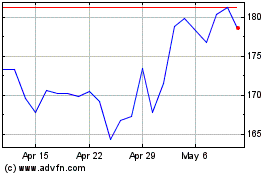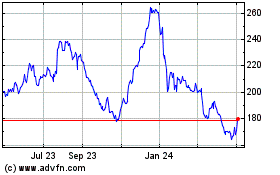By Andy Pasztor and Andrew Tangel
House Democrats issued a sharply worded report revealing new
details of how the combination of Boeing Co. design errors, lax
government oversight and lack of transparency by the plane maker
and regulators set the stage for two fatal 737 MAX crashes.
The 238-page document, written by the majority staff of the
House Transportation Committee, calls into question whether the
plane maker or the Federal Aviation Administration has fully
incorporated essential safety lessons, despite a global grounding
of the MAX fleet since March 2019.
After an 18-month investigation, the report, released Wednesday,
concludes that Boeing's travails stemmed partly from a reluctance
to admit mistakes and "point to a company culture that is in
serious need of a safety reset."
"We have learned many hard lessons as a company from the
accidents of Lion Air Flight 610 and Ethiopian Flight 302, and from
the mistakes we have made," Boeing said in a written response to
the report, referring to the two fatal MAX crashes. The
Chicago-based aerospace giant added: "We have been hard at work
strengthening our safety culture and rebuilding trust with our
customers, regulators, and the flying public."
The findings released Wednesday also questioned whether pending
changes inside the FAA would be sufficient to end what the report
describes as fundamentally inadequate government reviews of new
aircraft designs. Engineering and management errors on the MAX,
according to the report, reflect a flawed approval process in which
agency managers often undercut the authority of lower-level FAA
engineers, giving industry undue influence over the process.
The report blames "grossly insufficient oversight by the FAA,"
leaving the agency unable to appropriately meet its
responsibilities and ensure passenger safety.
Rep. Peter DeFazio, the Oregon Democrat who is the committee's
chairman, said the 737 MAX saga highlights the need for major
changes to U.S. air-safety regulation. "The problem is: It was
compliant and not safe, and people died," Mr. DeFazio said of the
aircraft in a press briefing Tuesday. "Obviously, the system is
inadequate."
Responding to the report, the FAA said it is "committed to
continually advancing aviation safety and looks forward to working
with the committee to implement improvements identified in its
report," adding that voluntary initiatives already are under way
based on lessons learned. The statement added that its focus is on
"improving our organization, processes and culture." The agency
reiterated that it has mandated design changes to the MAX and
"continues to follow a thorough process, not a prescribed timeline,
for returning the aircraft to service."
The report provides more specifics, in sometimes-blistering
language, backing up preliminary findings the panel's Democrats
released six months ago, which laid out a pattern of mistakes and
missed opportunities to correct them. Misfires of an automated
flight-control system, called MCAS, overpowered pilots and led to
two MAX crashes in less than five months that took 346 lives.
Fresh details in the report, however, show that various Boeing
employees recognized and repeatedly flagged some of those hazards
years before the FAA in 2017 certified the MAX as safe to carry
passengers, though their warnings failed to prompt high-priority
reviews by either the company or the agency.
Republican staffers participated in some interviews, including
with two high-ranking Boeing executives who defended the plane
maker's design process. But none of the panel's GOP members signed
off on the report.
Senior Republicans on the committee disputed the Democrats' call
for an overhaul of U.S. aircraft certification, dismissing the
report as partisan. "Expert recommendations have already led to
changes and reforms, with more to come," they said in a statement
setting the stage for debate over an air-safety bill the
committee's Democrats are expected to introduce in coming
weeks.
In one section, the Democrats' report faults Boeing for what it
calls "inconceivable and inexcusable" actions to withhold crucial
information from airlines about one cockpit-warning system, related
to but not part of MCAS, that didn't operate as required on 80% of
MAX jets. Other portions highlight instances when Boeing officials,
acting in their capacity as designated FAA representatives, part of
a widely used system of delegating oversight authority to company
employees, failed to alert agency managers about various safety
matters.
The longest portion of the document details previously
undisclosed safety concerns raised inside Boeing by lower-level
employees about the design and vulnerabilities of MCAS itself,
concluding those questions "were inadequately resolved or
dismissed."
In June of 2016, about a year before the FAA certified the MAX's
safety, a Boeing engineer sent a colleague an email that referred
to a company test pilot's difficulty leveling the plane's nose due
to repetitive MCAS activations.
After the engineer questioned whether the pilot's maneuvering
difficulty amounted to a safety issue, the colleague responded it
didn't, but noted that in such a situation, pilots could "find
themselves in a large mistrim," meaning the plane's nose could be
sharply pointed down. That was exactly the scenario that played out
in each MAX crash, with cockpit crews unable to regain control
after the planes' noses were forced downward by repeated, erroneous
MCAS activations.
In another exchange, a Boeing employee asked how MCAS would
react to faulty sensor data--which accident investigators would
later identify as a precipitating factor in both fatal crashes--but
the issue was dismissed by a colleague.
The report said the internal Boeing design concerns weren't
sufficiently resolved or addressed.
The House panel also highlighted internal Boeing documents
spanning 2015 to 2018 that noted a company test pilot's finding
that a slow reaction to an MCAS misfire--one taking longer than 10
seconds--could result in catastrophe.
The report said several Boeing employees working on behalf of
the FAA didn't share the test pilot's finding with the agency.
Boeing has said it relied on industrywide safety principles to
assume pilots would be able to respond appropriately to an MCAS
misfire in four seconds.
In its statement responding to the report, Boeing highlighted
steps it has taken in the wake of the MAX saga, which has cost it
billions of dollars, on top of lost revenue and a drop in
stock-market value, and significantly damaged its reputation. "We
have made fundamental changes to our company," Boeing said, noting
"change is always hard and requires commitment" and adding it is
dedicated to doing that work.
Delving into the period between the two crashes, the report said
both the FAA and Boeing "seemed more intent on justifying their
previous mistakes than in fully confronting the safety issues." And
committee investigators presented a picture of the FAA's safety
chief, Ali Bahrami, as divorced from day-to-day concerns about the
MAX. According to the report, Mr. Bahrami told the investigators in
an interview that he hadn't seen Boeing's bulletin reminding pilots
of an emergency procedure days after the first MAX accident in
October 2018.
Mr. Bahrami also told House staffers he wasn't familiar with an
internal FAA risk assessment after the first crash, which projected
15 more fatal crashes over the decadeslong lifetime of the MAX
fleet if Boeing didn't add safeguards to MCAS, the report said.
"I'm not familiar with the details of it," Mr. Bahrami told the
committee's investigators in a December 2019 interview, according
to the report. Mr. Bahrami acknowledged he decided fixes to MCAS
could wait while the plane kept flying, because he and other FAA
officials believed pilots would be able to intervene to avoid a
crash. Echoing Boeing's initial defense of its MCAS design after
the first crash, the FAA official said "pilots are part of the
system, and we rely on pilots to do certain things."
The transcript of Mr. Bahrami's interview with House
investigators shows he said he didn't recall any conversations with
Boeing counterparts in the nearly five months between the two
accidents. The report, however, cites emails showing he scheduled a
call with a high-ranking Boeing executive to discuss the crash in
Indonesia, though it wasn't clear to the committee's investigators
whether the conversation took place. The FAA had no specific
comment on Mr. Bahrami's testimony.
But in a message sent to FAA staff Tuesday, which was reviewed
by The Wall Street Journal, Mr. Bahrami alerted them to the House
panel's findings. "While the report is critical of both Boeing and
the FAA, it offers valuable insights into how we can improve,"
according to the message. After reiterating agency initiatives he
supports, Mr. Bahrami's message also urged employees to "work
together to further enhance our safety processes."
Write to Andy Pasztor at andy.pasztor@wsj.com and Andrew Tangel
at Andrew.Tangel@wsj.com
(END) Dow Jones Newswires
September 16, 2020 05:14 ET (09:14 GMT)
Copyright (c) 2020 Dow Jones & Company, Inc.
Boeing (NYSE:BA)
Historical Stock Chart
From Mar 2024 to Apr 2024

Boeing (NYSE:BA)
Historical Stock Chart
From Apr 2023 to Apr 2024
